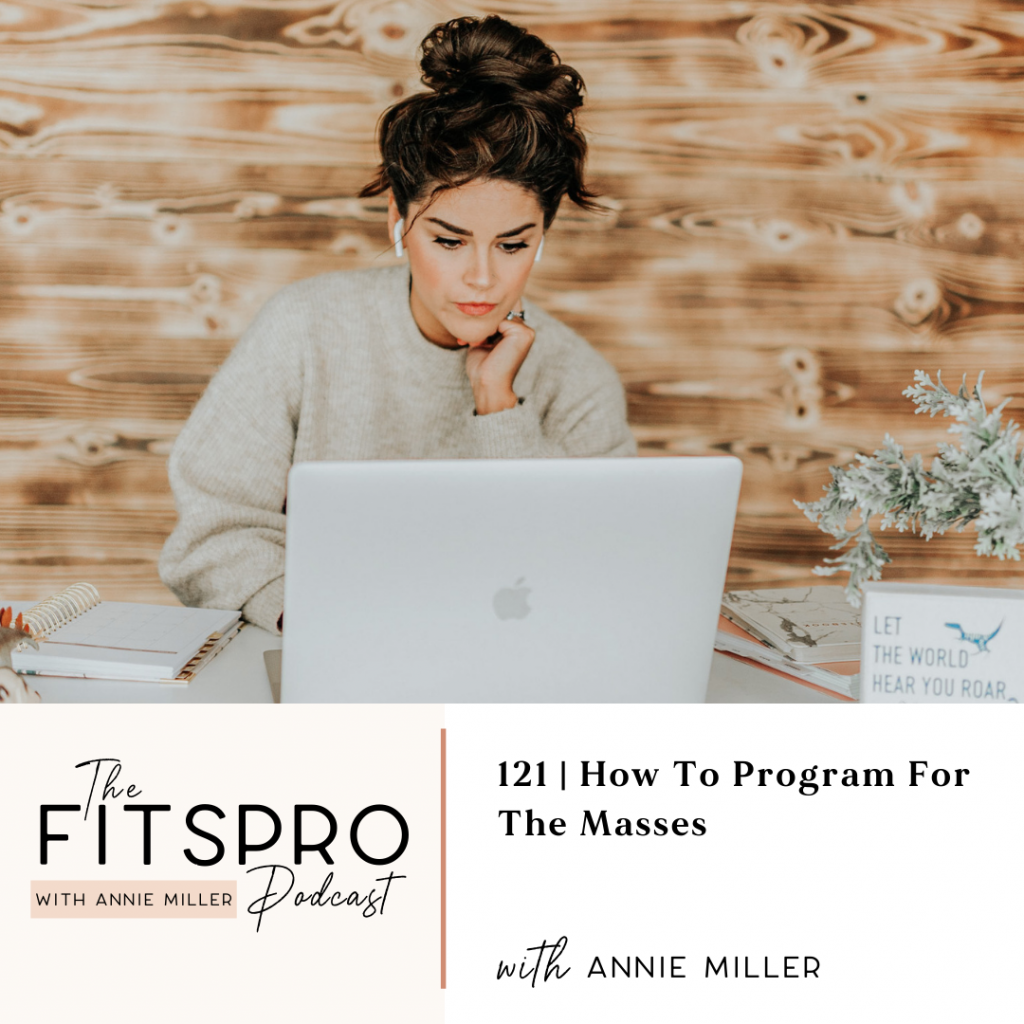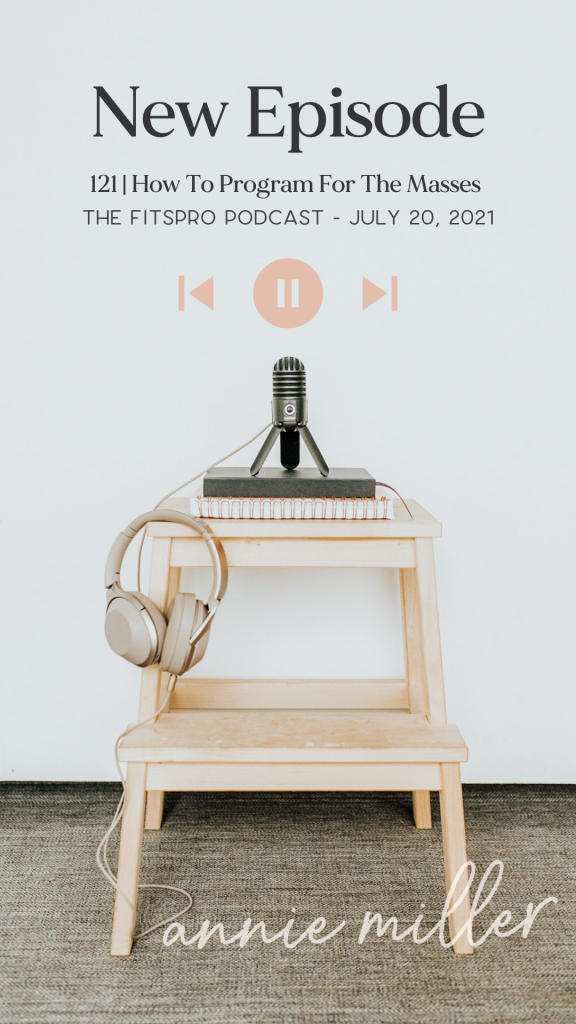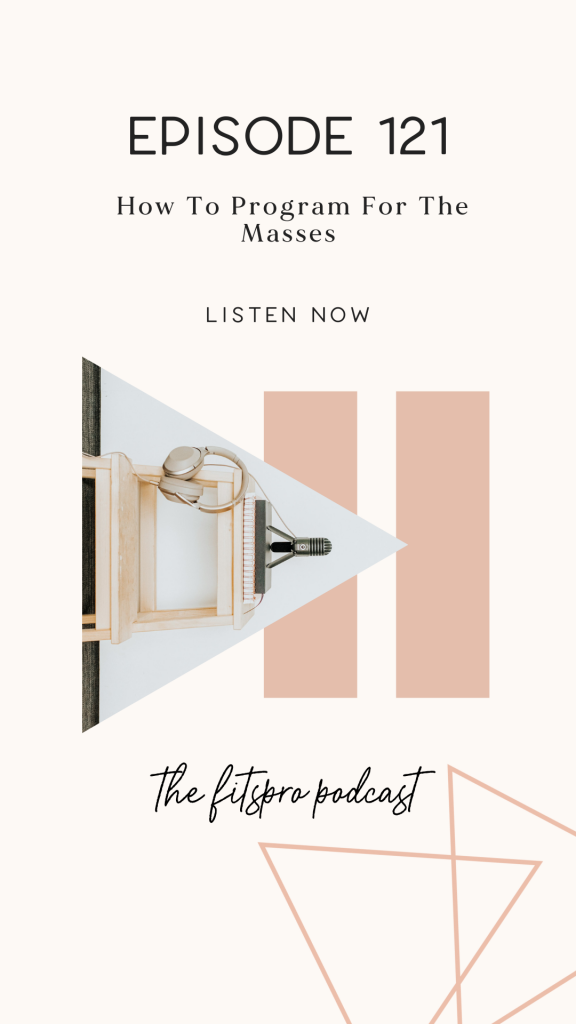the blog
welcome to
looking for something specific? find it here
Podcast: Play in new window | Download (Duration: 19:12 — 26.5MB)
Subscribe: Google Podcasts | RSS

This episode was inspired by answering several programming questions over on the gram. My audience seems to want to know what type of programming works for what type of client. And how we program beyond 1:1.
Some professionals are 1:1 or nothing. And I get that. Because nothing will get you more personalized results than working with a 1:1 coach. But what about those who don’t need 1:1 or can’t afford 1:1 services? Are they not deserving of quality fitness programming? I think not.
We can’t talk about this without touching on the idea of scaling your health and fitness business. I’ve said it before. But we have two options which both stem from one idea. The idea is to create more of YOU – to reach more people with your services.
That can happen via two main paths or a combination of them both:
1. You can hire more 1:1 coaches to fill gaps in your coaching while offering the 1:1 service you’ve built.
2. You can take what you’ve learned from filling your 1:1 roster, and create a lower-touch membership or group program. This is templated, or mostly templated and people can do it without needing you as their 1:1 programming coach.
If you’re here for the business side of things, then go ahead and join my free on demand workshop, Your Biz | Your Way – 3 steps to build a profitable online health and fitness biz
And while you’re on the site, snag all the free resources – you’ll find goodies for trainees and coaches or entrepreneurs alike. Much love.
Today’s episode tackles the latter of those two options. Templated programming for the masses.
It is needed, there is space for it, and it’s lucrative. We can reach more humans with a lower demand on our personal time.
This is not for everyone. Maybe it doesn’t fit your long term business model. But if you’re listening to this episode, I assume you’re interested.
Before diving in, I am not your program guru, the smartest, or best at programming. So, take what makes sense for you, and discard the rest.
Creating program templates can be a great tool even for 1:1 coaches who find that many of their clients need the same thing, or have the same issues. Maybe you find a general week set up that worked really well? Save it as a template. Like a skeleton.
So, let’s get after it.
We’re going to cover TIMELINE, as well as what goes in the program.
How many phases are you creating? We cannot just start programming willy nilly. We need structure so that we can make sure we get done what we’re trying to get done.
You’ll determine the length of your program time via consideration of your biz and offer model. How often are you opening the doors or launching? Is it a program you want people to be able to stay in and/or repeat time and time again?
I am sure you can see how these questions would help guide the length of the program and how many phases you need to create. Some coaches have ongoing programming that they create month after month forever and always. That’s an option. Some coaches have 12-16 week or 6 month programs. Some have 12 month programs. And these can likely be repeated, or not.
Nothing is right or wrong. That’s important to grasp. You simply get to choose and what to make sure it fits with your big picture plans for the program. 🙂 If we’re scaling, we want to make sure the program is, well, scalable.
Once you determine your timeline, let’s ask some more questions regarding the actual program:
- What is the goal of the program?
- How many days per week will it be?
- What are the daily duration expectations?
Programming for the masses is like sculpting a masterpiece out of stone. You’re essentially chipping away everything you don’t need in order to find only what is essential for the program. Find what is needed. Leave the rest.
- What is the goal of your program?
Look at all your 1:1 or even group and in person experience. What are the common desires of these people? And their past training experience? What did they tend to struggle with? Think about movement patterns and mobility etc. How might you consolidate these things in your program?
If the masses want X, how can we program that? What if they have rounded upper backs, and a weak core, how can we address that in a way that benefits them? If grip is a limiting factor for most people in deadlift, how can we weave in grip work?
You see – it is that simple to start. In your experience, what do your clients want, love, and struggle with? How can you begin to develop a program that addresses all of these things? How can you get as close as possible to what you do for your 1:1 clients, for the masses? That’s one goal to think about.
You’re going to have ZOOM WAY OUT. If you’re used to programming for 1:1 it’s super normal to let the “but what if” thoughts slide in. What if they want this though? What if they struggle with this though? Remind yourself, that we are not writing a 1:1 program! What will benefit MOST PEOPLE. That’s what we’re after.
What training splits have you found that work really well for your clients?
That’s your base.
For me, that’s a classic upper, lower split with an extra day for tune up work and conditioning. So, that’s how I tend to program. That can be done in 3, 4, 5, or 6 day set ups.
How many days per week will your program be? Base this largely on market research within your audience! Nothing is off limits. It just needs to make sense and be marketable to your audience.
Plug in your preferred training split to the days-per-week model that you’ve chose.
Once you have your program purpose, timeline model, split, and days per week, you begin programming.
Are these lifts 30 minute wods? Do people need to expect to spend 75 minutes in the gym? Don’t write a program that doesn’t do what you set out for it to do.
Within your split, start plugging in those struggles and desires my friend.
Warm up – what does it look like? Are you do a full body repeated daily warm up? That’s an option.
Are you doing what I call “movement prep” – a warm up specific to the days movements and popular limitations.
Your warm up is where we can work some of those common issues – ankle, hip, and t spine mobility, core awareness and strength etc.
You can create your warm ups first. OR, create the main lift and accessory, then come back and create a warm up that makes sense for the day. Up to you!
What exercises do you find yourself using with your 1:1 clients often? Gravitate towards those! And likely, keep it simple.
What set and rep ranges do you tend towards? USE THOSE! But of course, keep the purpose of your program in mind.
I am not getting specific because I am not telling you how to program for strength, or hypertrophy. You should have an idea at this point of your style and programming philosophy. I am aiming to help you take that knowledge and apply it to more humans.
Progression is where people I’ve spoken to seem to get a bit stuck.
Do you progress the warm up? How do you know when to change what?
Yes progress the warm ups if possible. Or change them up. Example: We can go from a dead bug to a static bear crawl series. One is open chain, the other is closed chain. Same body position, different load. You feel me?
When working with the masses we want to make sure we’re managing volume and that changes in tempo or exercise selection make sense. No going from conventional deads at 3×5 to sumos at 3×10. What are we doing here? You know? Now, I have also seen people program each month with a completely new goal and focus. It’s a thing., an option. Just not my favorite approach. But that’s because it doesn’t make sense for me or my clients. You do what makes sense for you!
Okay, I know that was basically a shit ton of questions…but I hope they brought some level of clarity and structure to how one might transition from 1:1 programming to programming for the masses.
It can be done. It simply requires clarity and a plan. And maybe some market research within your audience at large. 🙂
If you find value here, on The FitsPRO Podcast, then pretty please head over to iTunes, subscribe, rate and review the show. It means the world to me when you spread my message to more humans.
Want more podcasts? Click here to skim the archives.
P.S. Save this value packed episode for later over on Pinterest!
ALL THE LINKS YOU NEED:
Free On Demand Workshop: 3 Steps To Build a Profitable Online Health and Fitness Business
Supplements: Legion Athletics Code ANNIE for 20% off
Skincare: Fré Skincare Code FDBA for at least 15% off
Bags: Vooray Code ANNIE for 20% off
I'm an adventurous introvert from Vancouver, Washington who lives on sleep + "me time." I'm a lover of lifting weights, dinosaurs, real talk and traveling with my husband. I am here to help you move better, lift more, bust the myths of the fitness industry, and inspire you to love the process.
Hey you,
The name's Annie & you're reading my thoughts. Let's get acquainted.
the whole story >
looking for something specific? find it here
THE LINKS BELOW ARE AFFILIATE LINKS
SKIN CARE
Nutrition
brands I love
working against gravity
Fre skin care
favorites
blue light blockers
klassy network
code: fdba saves you 15% off
online TRAINERS
save $50
code: ANNIE saves you 20% off
You love my style, trust my reviews, and want more Annie Miller Concepts vibes in your life? Shop my favorite brands. You get awesome products and yours truly gets a little kick-back.


